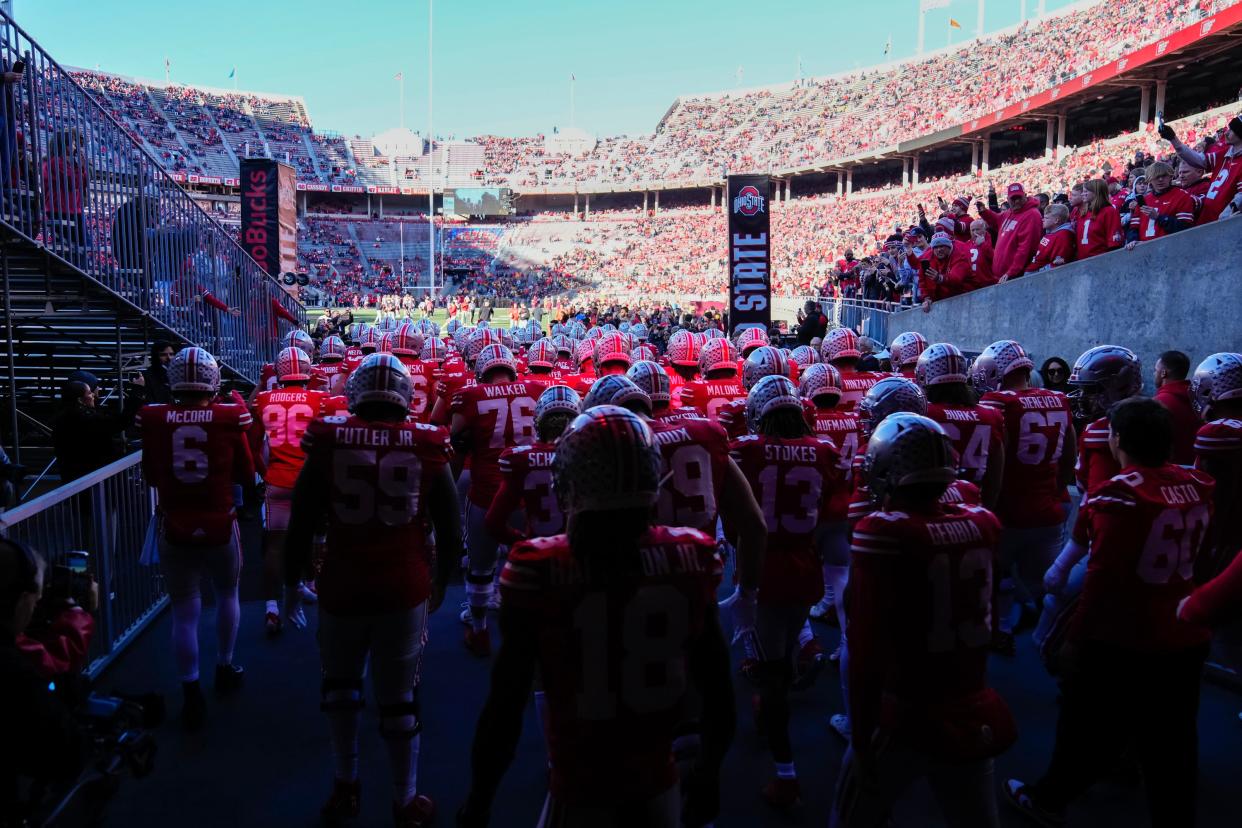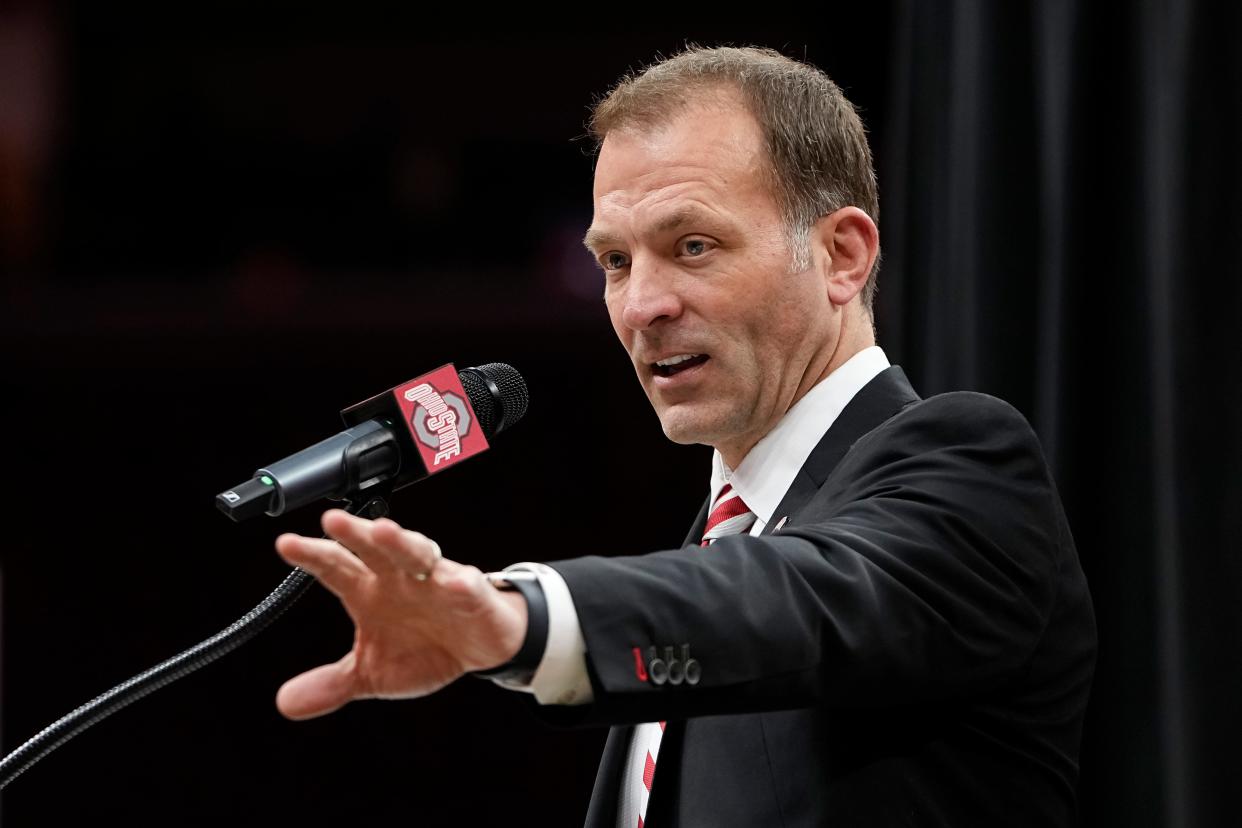Ohio State to pay athletes maximum allowed following NCAA settlement, AD Ross Bjork says
Ohio State is preparing to begin revenue sharing with its athletes next year, provided a landmark legal settlement of three antitrust cases against the NCAA is approved by a federal judge, incoming athletic director Ross Bjork told The Dispatch.
“Absolutely,” Bjork said. “What we’re working on right now is what that plan looks like.”
Under the proposed terms of a settlement that is poised to further alter the landscape of college athletics, schools will be permitted to share millions of dollars in revenues from their media rights deals, sponsorships and ticket sales. It does not require schools to participate in the new compensation model.

The direct payments to athletes, set to begin in fall 2025, would be capped at 22% of the average major conference school’s primary revenues, resulting in a figure that reaches around $22 million annually and increases by percentage points over the following years.
Bjork, who replaces Gene Smith at the helm of Ohio State’s athletic department on July 1, said the Buckeyes would pay the maximum total to athletes.
“We know the percentage,” Bjork said. “We know the rough calculation. We know there are escalators. That’s about all we know right now.”
Questions linger about how the money will be distributed to the more than 1,000 athletes participating in 36 varsity sports at Ohio State, which is tied with Stanford for the most among schools in Division I’s major conferences.
Title IX, the federal law that oversees gender equity in college sports, is perhaps the biggest variable.
Based on the latest legal guidance presented to the athletic department, Bjork anticipates the amounts disbursed to male and female athletes will need to be proportional to their enrollment at the university, an arrangement that mirrors the allocation of scholarship money under the law.
Ohio State’s enrollment for the latest academic year was 52% female and 48% male, meaning that payments could be about equal between the genders.
“We are committed to Title IX,” Bjork said. “We have to be. It’s the right thing. But it’s also federal law.”

How payments are further broken down among the men’s and women’s sports teams remains unknown.
Bjork said he did not expect the payments to be evenly divided between the athletes, a scenario likely to result in some sports receiving greater financial resources.
“There are going to be hard decisions,” Bjork said, “because it’s a recalibration of the model.”
One of the most pressing dilemmas is how much of a split should go to football and men’s basketball, the sports that generate the most revenue for athletic departments and are likely to demand the most funding in order to entice high school recruits and transfers in an increasingly competitive marketplace for talent.
“This is the equation that everybody’s got to figure out,” Bjork said. “If you have $11 million for men’s sports, how much goes to football? We have a lot of basketball tradition-laden programs in the Big Ten. There are basketball powerhouses that don’t have football. They could spend all $11 million on basketball.
“But if we also have to do football here at Ohio State, which we will, what does that leave for basketball? Those are all the challenges that we have to map out.”
An attempt to bridge any potential gaps is to be made through compensation from booster-supported collectives or other business entities that strike name, image and likeness deals with athletes.
Ohio State has two primary NIL collectives in operation between The 1870 Society and THE Foundation, contributing to an infrastructure Bjork described as “really aggressive.”
“Revenue sharing is great,” Bjork said, “but NIL is not going away, and we would be naive to think $22 million is going to be the market, and it’s going to increase, but that’s not going to be the market. It’s going to be that, plus NIL, and the programs that figure out the NIL infrastructure are going to thrive. We want to be one of those programs.”
The antitrust case settlement, which also includes the NCAA paying former athletes nearly $2.8 billion in back damages, is not the first instance in recent years that an outcome from a courtroom led to schools paying their athletes.
A unanimous ruling by the U.S. Supreme Court in 2021 removed the college sports association’s limits on education-related compensation.
The case resulted in revised NCAA rules that allowed schools to pay as much as $5,980 to athletes over an academic year.
By fall 2022, Ohio State began offering academic achievement awards to athletes who were in good academic standing, earning minimum credit hours, meeting NCAA-mandated making degree progress and earning all available Academic Progress Rate points.
According to information provided to The Dispatch through a public-records request, the school distributed $2.58 million in academic bonuses during the program’s first semester.
Officials said at the time the athletic department was budgeting about $6 million a year to cover the payments.
The burden on the department, though one of the wealthiest in the nation, will be higher with revenue sharing, an expense seemingly poised to make up nearly 10% of its annual operating budget.
In Ohio State’s latest financial statement provided to the NCAA, it reported athletics operating revenues totaling $279.5 million over the 2023 fiscal year.
The revenue-sharing payments totaling $22 million would make up one of the department’s highest expenses.
Only five categories would be higher — support staff and administrative compensation ($45.5 million), athletics facilities and debt services ($45.3 million), coaching salaries ($45.3 million), direct overhead and administrative expenses ($32.3 million) and athletic student aid ($23.8 million).
To offset the added expenses, Bjork pointed to a need for more earnings with potential new sources of revenue.
“Fundraising in this era and revenue generation has always been a priority,” Bjork said, “and that’s been my background, but even more so in this new model.”
Joey Kaufman covers Ohio State football for The Columbus Dispatch and can be reached at jkaufman@dispatch.com.
Get more Ohio State football news by listening to our podcasts
This article originally appeared on The Columbus Dispatch: Ohio State to pay athletes maximum allowed following NCAA settlement
